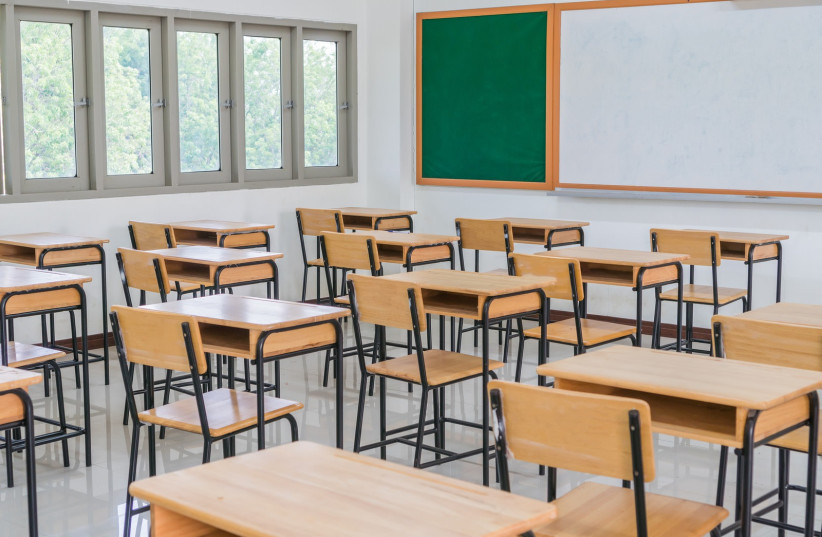Five months after schools in Sderot – 12 kilometers from Gaza – were evacuated due to the dangers of rockets and terrorists causing alarms to sound, anxiety, panic, and uncertainty, they have finally been reopened.
But children and their educators are still worried, and they try to return to their pre-October 7 routine. The Israel Institution for Occupational Safety and Health (IIOSH) offers school principals advice on how to create a calm and safe return.
There are 88 kindergartens, 12 elementary schools, five intermediate schools, and one special-education school in the city of more than 35,000 residents that was founded in 1951 near a transit camp for new immigrants.
Immediately after the events of October 7, pupils were sent to dozens of different temporary education frameworks and facilities established throughout the country and had to cope with prolonged separation from their homes and the neighborhoods in which they grew up and were educated – but returning to school does not diminish the level of guidance and protection against missile fire on the city.
For the school principals to fulfill their responsibility to manage the running to the protected space, their voices must be heard during the alarm and the noise of the panic. A hand-held loudspeaker is the required means to be within reach of every principal. Through it, instructions and guidance can be given to children and staff to ensure safe arrival at the protected space.

If the alarm sounds, pupils and staff are required to act according to the practiced drills for quick and safe arrival at the protected space. During the short time it takes to reach it, school principals must leave their offices for a point from which they can influence and manage exceptional events that may occur during the movement to the protected space.
Sirens in the south
In most areas of the country, the time for taking cover is defined as a minute and a half. In areas close to the borders, the time for taking cover varies and ranges from the following time frames: immediate, 15 seconds, 30 seconds, 45 seconds, and a minute. These short times require immediate exit and going quickly to the protected space.
The alarm siren, the movement noise of the evacuating pupils and staff, and their rapid movement to the protected space create noise and panic. Upon identifying risk or a gap, the principal must act, manage the event, such as blocking passages and changing location, giving instructions and guidance, and managing safe arrival at the protected space.
In case of an alarm, the principal with a loud voice will have difficulty overcoming the noise of the alarm and the panic during an event. These are the safety guidelines that every principal must know in an emergency situation:
Every educational institution manager must ensure that they have a hand-held loudspeaker available to them at all working hours. The hand-held loudspeaker will make possible the transfer of information and management that can be heard during the arrival at the protected space and in the protected space.
During practice drills for arriving at the protected space, the managers will practice managing the teachers and pupils using the hand-held loudspeaker and ensure that their voice is heard and instructions are communicated and implemented during the arrival at the protected space and back to the learning environment.
Ensure that the teachers are familiar with the risks and the methods of handling them. The teachers have undergone training and daily refreshers for clearing open routes to the protected space, as well as all the actions required of each staff member during an alarm and evacuation to the protected space to protect against missile fire.
Ensure that those in charge are familiar with the required actions from the moment the alarm sounds, work is stopped, and until leaving the protected space and resuming activity, communication and information transfer, event management, first aid in case of missile fire damage, such as the arrival of first aid responders, self-assistance team and intervention team trained and qualified for their role to the scene of the incident.
Make sure that a plan based on risk management and the instructions of the Home Front Command is in place, allowing employees to reach a protected area in all work areas or that the employee has the equipment for self-protection in the field.
Emergency lighting must be lit in the protected area, staircases, and evacuation route, checked regularly, and found to be operational. The evacuation routes must not be blocked, and throughout all working hours, the passages must be clear.
Bomb shelter doors and evacuation doors must be operational, unlocked, accessible without interference, and can be opened at all working hours.
IIOSH director-general Dr. Mickey Winkler, summarized that “we welcome the return of pupils from the city of Sderot to their homes. During the return of the educational institutions to the emergency routine, it is important that every manager in the city knows that he has a hand-held loudspeaker for managing the students and staff during an event while hearing the alarm and ensuring the safety of the teachers and students.
We call on them to ask the Home Front Command instructors to help in training and preparing the school for emergencies, especially during these days of the Gaza war, to prevent unnecessary accidents and injuries.”
